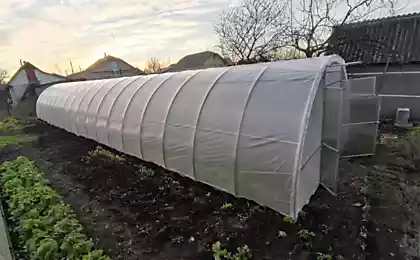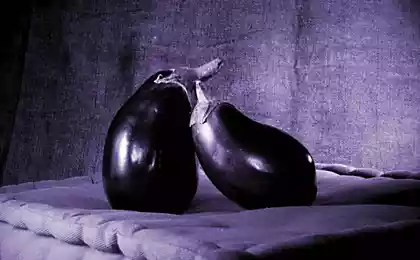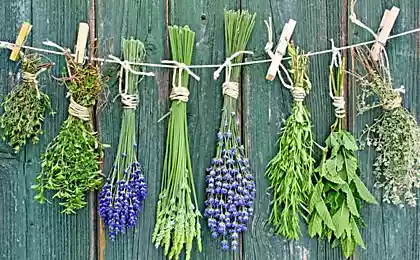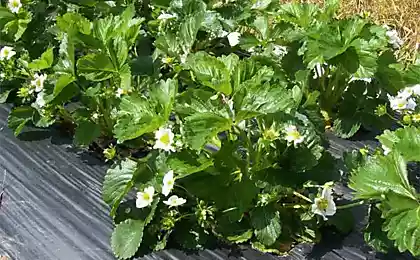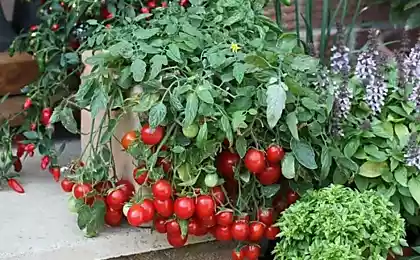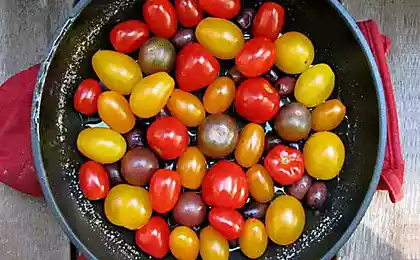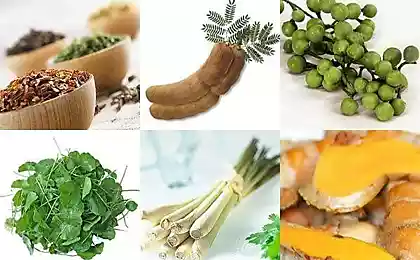674
The correct sequence of growing plants in Your beds
Crop rotation of vegetable crops is a necessary alternation of cultivated plants in Your garden beds. Crop rotation in the vegetable garden should ideally be annual and ongoing. This means, on one and the same place for two or more consecutive years nothing to grow. This, of course, ideally, and to implement such a utopian picture is not every cottager under force. However, "the Gardener and the gardener" I'll try to help You in this difficult matter.
We have prepared for You is certainly useful charts and tables, download which as usual, You can use the link at the end of the article. Meantime, let's get to the theory.
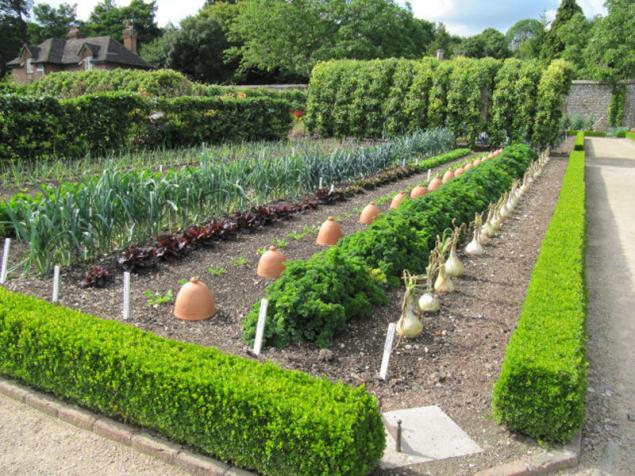
Crop rotation of vegetable crops: table for busy gardeners
Basically, your rotation isn't quick and takes time. This is because with crop rotation you need to consider a lot of factors: the need of plants in nutrition, belonging to the biological family, the infestation of soil pests, etc. but Those who have not enough time for long calculations and design, we offer a quick and easy solution.
"Table rotation: followers and predecessors vegetables when planting" will help You navigate in choosing plants for a particular garden, without going into details. The only thing to remember while using it – culture can return to his former place at least 3 – 4 years.
Table rotation: followers and predecessors vegetables when planting
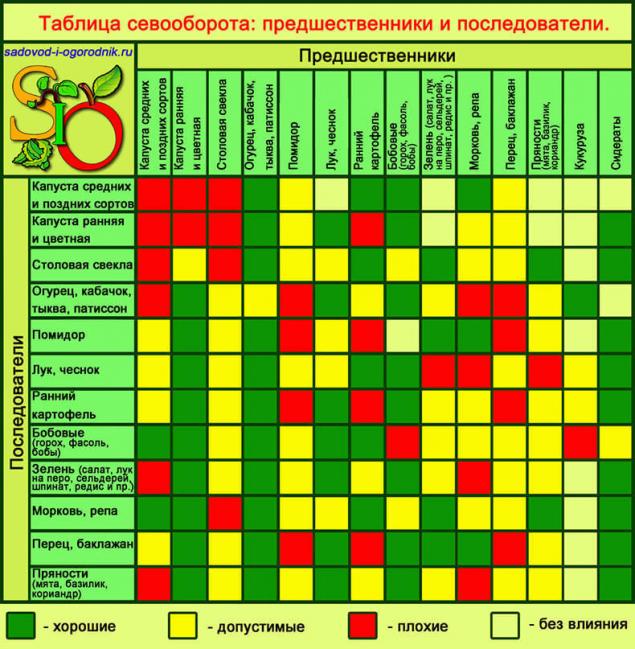
As can be seen from this matrix to the rotation, is the best precursors of vegetable crops, acceptable and bad:
— The best precursors for tomatoes - cauliflower and early cabbage, cucumbers, squash, pumpkins, greens, carrots and green manure. Acceptable to plant the tomatoes after the onions, garlic, herbs, beets, cabbage and medium-late varieties. After other crops are planted on the bed of tomatoes is not worth it.
— Great predecessors cabbage – cucumber, zucchini, pumpkin and beans. But then comes the separation. For late and medium varieties of good early potatoes and carrots, and early and cauliflower it is better to plant after green manure and onions with garlic.
Are good precursors of onion and garlic (which You cultivated green) – color and early cabbage, cucumbers, zucchini, pumpkins, early potatoes, peas, beans, beans and green manures.
Best predecessors cucumbers, zucchini, pumpkins, etc. – onions, garlic, beans, maize, early and cauliflower.
Good predecessors peas – any cabbage, early potatoes, cucumbers, courgettes, pumpkins and squashes.
Great predecessors carrot – cabbage, potatoes, herbs and spices, cucumbers, zucchini and green manure.
The best predecessors of pepper and eggplant cucumber, onion, carrot, green manure, etc.
Good predecessors beet, spices and herbs, potatoes, cucumbers, etc.
— The remarkable predecessors of potatoes, zucchini, garlic, legumes, green manures, etc.
I think, to understand how a table that You managed without too much difficulty. So, the "bustler" we leave and we move on.
Crop rotation of vegetables in the garden: a necessity or a whim
The cottagers, who is not limited in time "Gardener and the gardener" suggests "to dig deeper". First, let's consider the objective reasons which indicate undoubted practical benefits and the necessity of crop rotation in the country.
The causes of soil fatigue:
1. The accumulation of pests and pathogens.
If a long time to put on one and the same place, for example, potatoes, then this area will inevitably increase the number of wireworms, Colorado potato beetles and pathogens of Phytophthora. As is the case with other cultures. Growing all the time in the same beds of the same vegetables You may get on one the dominance of onion flies, to another cabbage Clubroot, on the third carrot flea beetles, etc. to say nothing of the root and leaf nematodes, rots and other "small" troubles.
2. The accumulation of toxins.
Another reason which speaks of the necessity of vegetable crop rotation is inevitable toxic root allocation — Colin. Many vegetable crops are very sensitive to their own toxins. If you continue to put them in one place, it crops each year will get worse and worse, even despite the lack of pests and diseases. For example, the most receptive to their root excretions spinach and beets. A little easier to react to them parsley, radish, radishes, celery, carrots and pumpkin crops. Less likely to suffer from Kalinov corn, leeks and legumes. Many toxins remain in tomato, cucumber, carrot and cabbage beds.
3. The nutritional needs.
The nutrient supply is not limitless. Each plant has its own requirements for nutrients. Some cultures are less demanding, and some more. Because it is very important to know "who is who" to track the status of the individual beds. So if planted in the same place related plants, they in a few years will "suck" all of it is necessary for growth, and had spent the stock of some items. As a consequence, yields will fall.
All of these factors combine to give the so-called exhaustion of the soil. To deal with this. The most effective way – this is the crop rotation of vegetables to Your cottage.
Crop rotation in the garden: confronting soil degradation
To the above-described the horrors of not become a reality at Your favorite country or area, it is enough to remember and follow three simple rules of crop rotation.
1. The rule of botany.
You should never put each other not just one and the same plant, but even culture related, belonging to the same species! This is the first, most important.
Judge for yourself:
— Diseases and pests they are often the same. Consequently, the first cause cannot be eliminated.
— Toxins are the same. Processed Colina one plant just the culture of other Botanical species. Hence the second reason will remain in place.
— Nutrition and the need for micronutrients in crops of the same family were also virtually identical. It turns out that the third reason is not going anywhere.
Conclusion: the crop rotation of vegetables in the same Botanical family is useless!
2. The time rule.
The longer the culture is not refundable – the better!
The minimum period over which you can return the plant to its original place – 3 years. For carrot, parsley, beets, cucumbers it is better to increase up to 4-5 years. Cabbage, when you are prompted kila to return only after 6-7 years. If possible (enough space grown cultures), feel free to increase these numbers will only get better.
Otherwise, again, are not eliminated those three causes exhaustion of the soil.
3. Rule of fertility.
Determining the order of alternation of crops in crop rotation, remember about nutrition and about the plants that help enrich the soil the necessary elements.
All crops use the nutrients for their growth, some more, some less. Very demanding on the power plants should not be planted after each other.
Some crops improve the soil by the very fact of their growth on this site. These include almost all legumes. They only loosen the soil, but fill it with mineral elements. No wonder many vegetables love them as predecessors. By the way, similar qualities of plants and other species whose root system is deep, powerful and well-developed.
Others contain essential nutrients in their roots and leaves. These plants need to know and put in the compost. Although this is a separate issue, a few examples will bring.
The content of nutrients in plants:
— buckwheat and melon leaves – calcium,
— the leaves of Datura – phosphorus,
— the stems and leaves of tobacco – potassium,
— dioecious nettle – iron.
In accordance with this rule, advise You in the preparation of the sequence of crops in rotation to pay attention not only to Botanical species and timing, but also on the demands to feed and improve fertility. Thus:
— after each plant, demanding of food, for the next year is to plant legumes or seriously to fertilize the garden,
— after at least demanding vegetables you can plant more demanding, moderately fertilized soil.
To make it easier to navigate with the alternation of crops in crop rotation, "the Gardener and the gardener" has prepared a special Bulletin.
Memo: "What to consider when alternation of vegetable crops in crop rotation"
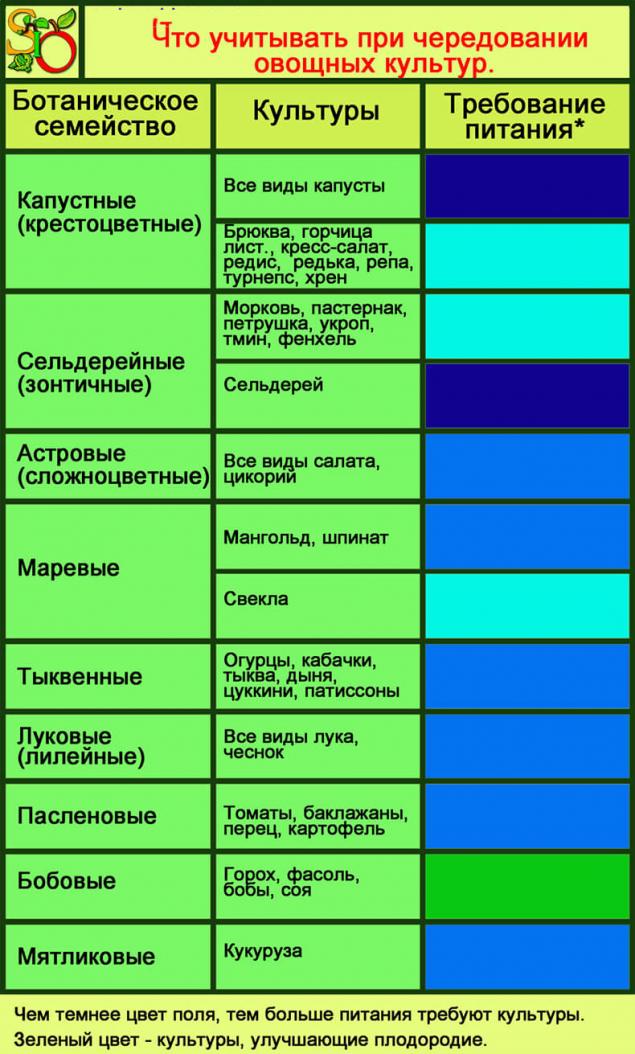
Rotation pattern of vegetables in the country
To give some variants of schemes of crop rotation is a waste of time. Suburban plot each gardener is unique, and so very few people can come up some standard plans for rotation of crops. And it's not even the size of land or number of beds. Just vegetables, which are cultivated each are different. Someone sits down a lot of cabbage of different kinds, and someone literally 5-6 plants. Someone plants potatoes on 5 acres, and someone enough 5 square meters. Someone planted many crops in the greenhouse, and someone has a greenhouse just for tomatoes and cucumbers. Because feasible vacationers to plan the crop rotation and to make an individual scheme.
The main principles which should adhere to, we have sounded above. Now let's step back from the ideal and into reality. Further, "the Gardener and the gardener" offers a list of practical tips for device rotation.
The rotation on the dacha: practical tips
1. Human memory is not limitless. Remember that vegetable was on this bed five years ago – an impossible task for most truckers. Because the first tip – do not be lazy and draw in a notebook the plan of site with all the beds. On this plan each year You will be celebrating the planted culture. Those who have a lot of free time, can immediately mark likely for planting plants for a year or two or three ahead. The rest to make a full map rotation will be required 5-6 years (number average time of the return of the culture).
2. In the process of sowing, decide and write down in your book and how much space what culture You have is (one third of the beds, a quarter, half, whole, etc.). It is necessary that in the following years it was possible to "stack" the perfect landing, as the pieces of the puzzle. It is not necessary to sow the whole bed of any one culture. If an onion can be planted cabbages and greens, and make – podgradci one, podgradci second. Just remember to verify compatibility of plant neighbors.
3. If you change the place of some cultures does not work (well, it happens sometimes), don't despair. Just add her on the bed "neighbor" from another family (not forgetting to check compatibility table). So plants smoktravel (beets, spinach, carrots, etc.), we talked about the second reason (Accumulation of toxins), can grow in one place quietly and without losses in yield of up to 3 years. After all the neighbors of another species well recycle and absorb those harmful toxins. Combined fit works best when combined. That is not podgradci beets and podgradci carrot, and some after another. Or better yet, fill the aisle with the same beans.
Here, perhaps, all the information that You need to arrange the proper and effective crop rotation in the country. The table will help quickly determine the sown culture. Memo – plan everything in advance. Practical advice to solve emerging problems. Good harvests! published
P. S. And remember, only by changing their consumption — together we change the world! ©
Join us in Facebook , Vkontakte, Odnoklassniki
Source: sadovod-i-ogorodnik.ru/177-sevooborot-ovoschnyh-kultur-tablica-predshestvenniki-ovoschey-organizaciya-cheredovaniya-na-dache.html
We have prepared for You is certainly useful charts and tables, download which as usual, You can use the link at the end of the article. Meantime, let's get to the theory.

Crop rotation of vegetable crops: table for busy gardeners
Basically, your rotation isn't quick and takes time. This is because with crop rotation you need to consider a lot of factors: the need of plants in nutrition, belonging to the biological family, the infestation of soil pests, etc. but Those who have not enough time for long calculations and design, we offer a quick and easy solution.
"Table rotation: followers and predecessors vegetables when planting" will help You navigate in choosing plants for a particular garden, without going into details. The only thing to remember while using it – culture can return to his former place at least 3 – 4 years.
Table rotation: followers and predecessors vegetables when planting

As can be seen from this matrix to the rotation, is the best precursors of vegetable crops, acceptable and bad:
— The best precursors for tomatoes - cauliflower and early cabbage, cucumbers, squash, pumpkins, greens, carrots and green manure. Acceptable to plant the tomatoes after the onions, garlic, herbs, beets, cabbage and medium-late varieties. After other crops are planted on the bed of tomatoes is not worth it.
— Great predecessors cabbage – cucumber, zucchini, pumpkin and beans. But then comes the separation. For late and medium varieties of good early potatoes and carrots, and early and cauliflower it is better to plant after green manure and onions with garlic.
Are good precursors of onion and garlic (which You cultivated green) – color and early cabbage, cucumbers, zucchini, pumpkins, early potatoes, peas, beans, beans and green manures.
Best predecessors cucumbers, zucchini, pumpkins, etc. – onions, garlic, beans, maize, early and cauliflower.
Good predecessors peas – any cabbage, early potatoes, cucumbers, courgettes, pumpkins and squashes.
Great predecessors carrot – cabbage, potatoes, herbs and spices, cucumbers, zucchini and green manure.
The best predecessors of pepper and eggplant cucumber, onion, carrot, green manure, etc.
Good predecessors beet, spices and herbs, potatoes, cucumbers, etc.
— The remarkable predecessors of potatoes, zucchini, garlic, legumes, green manures, etc.
I think, to understand how a table that You managed without too much difficulty. So, the "bustler" we leave and we move on.
Crop rotation of vegetables in the garden: a necessity or a whim
The cottagers, who is not limited in time "Gardener and the gardener" suggests "to dig deeper". First, let's consider the objective reasons which indicate undoubted practical benefits and the necessity of crop rotation in the country.
The causes of soil fatigue:
1. The accumulation of pests and pathogens.
If a long time to put on one and the same place, for example, potatoes, then this area will inevitably increase the number of wireworms, Colorado potato beetles and pathogens of Phytophthora. As is the case with other cultures. Growing all the time in the same beds of the same vegetables You may get on one the dominance of onion flies, to another cabbage Clubroot, on the third carrot flea beetles, etc. to say nothing of the root and leaf nematodes, rots and other "small" troubles.
2. The accumulation of toxins.
Another reason which speaks of the necessity of vegetable crop rotation is inevitable toxic root allocation — Colin. Many vegetable crops are very sensitive to their own toxins. If you continue to put them in one place, it crops each year will get worse and worse, even despite the lack of pests and diseases. For example, the most receptive to their root excretions spinach and beets. A little easier to react to them parsley, radish, radishes, celery, carrots and pumpkin crops. Less likely to suffer from Kalinov corn, leeks and legumes. Many toxins remain in tomato, cucumber, carrot and cabbage beds.
3. The nutritional needs.
The nutrient supply is not limitless. Each plant has its own requirements for nutrients. Some cultures are less demanding, and some more. Because it is very important to know "who is who" to track the status of the individual beds. So if planted in the same place related plants, they in a few years will "suck" all of it is necessary for growth, and had spent the stock of some items. As a consequence, yields will fall.
All of these factors combine to give the so-called exhaustion of the soil. To deal with this. The most effective way – this is the crop rotation of vegetables to Your cottage.
Crop rotation in the garden: confronting soil degradation
To the above-described the horrors of not become a reality at Your favorite country or area, it is enough to remember and follow three simple rules of crop rotation.
1. The rule of botany.
You should never put each other not just one and the same plant, but even culture related, belonging to the same species! This is the first, most important.
Judge for yourself:
— Diseases and pests they are often the same. Consequently, the first cause cannot be eliminated.
— Toxins are the same. Processed Colina one plant just the culture of other Botanical species. Hence the second reason will remain in place.
— Nutrition and the need for micronutrients in crops of the same family were also virtually identical. It turns out that the third reason is not going anywhere.
Conclusion: the crop rotation of vegetables in the same Botanical family is useless!
2. The time rule.
The longer the culture is not refundable – the better!
The minimum period over which you can return the plant to its original place – 3 years. For carrot, parsley, beets, cucumbers it is better to increase up to 4-5 years. Cabbage, when you are prompted kila to return only after 6-7 years. If possible (enough space grown cultures), feel free to increase these numbers will only get better.
Otherwise, again, are not eliminated those three causes exhaustion of the soil.
3. Rule of fertility.
Determining the order of alternation of crops in crop rotation, remember about nutrition and about the plants that help enrich the soil the necessary elements.
All crops use the nutrients for their growth, some more, some less. Very demanding on the power plants should not be planted after each other.
Some crops improve the soil by the very fact of their growth on this site. These include almost all legumes. They only loosen the soil, but fill it with mineral elements. No wonder many vegetables love them as predecessors. By the way, similar qualities of plants and other species whose root system is deep, powerful and well-developed.
Others contain essential nutrients in their roots and leaves. These plants need to know and put in the compost. Although this is a separate issue, a few examples will bring.
The content of nutrients in plants:
— buckwheat and melon leaves – calcium,
— the leaves of Datura – phosphorus,
— the stems and leaves of tobacco – potassium,
— dioecious nettle – iron.
In accordance with this rule, advise You in the preparation of the sequence of crops in rotation to pay attention not only to Botanical species and timing, but also on the demands to feed and improve fertility. Thus:
— after each plant, demanding of food, for the next year is to plant legumes or seriously to fertilize the garden,
— after at least demanding vegetables you can plant more demanding, moderately fertilized soil.
To make it easier to navigate with the alternation of crops in crop rotation, "the Gardener and the gardener" has prepared a special Bulletin.
Memo: "What to consider when alternation of vegetable crops in crop rotation"

Rotation pattern of vegetables in the country
To give some variants of schemes of crop rotation is a waste of time. Suburban plot each gardener is unique, and so very few people can come up some standard plans for rotation of crops. And it's not even the size of land or number of beds. Just vegetables, which are cultivated each are different. Someone sits down a lot of cabbage of different kinds, and someone literally 5-6 plants. Someone plants potatoes on 5 acres, and someone enough 5 square meters. Someone planted many crops in the greenhouse, and someone has a greenhouse just for tomatoes and cucumbers. Because feasible vacationers to plan the crop rotation and to make an individual scheme.
The main principles which should adhere to, we have sounded above. Now let's step back from the ideal and into reality. Further, "the Gardener and the gardener" offers a list of practical tips for device rotation.
The rotation on the dacha: practical tips
1. Human memory is not limitless. Remember that vegetable was on this bed five years ago – an impossible task for most truckers. Because the first tip – do not be lazy and draw in a notebook the plan of site with all the beds. On this plan each year You will be celebrating the planted culture. Those who have a lot of free time, can immediately mark likely for planting plants for a year or two or three ahead. The rest to make a full map rotation will be required 5-6 years (number average time of the return of the culture).
2. In the process of sowing, decide and write down in your book and how much space what culture You have is (one third of the beds, a quarter, half, whole, etc.). It is necessary that in the following years it was possible to "stack" the perfect landing, as the pieces of the puzzle. It is not necessary to sow the whole bed of any one culture. If an onion can be planted cabbages and greens, and make – podgradci one, podgradci second. Just remember to verify compatibility of plant neighbors.
3. If you change the place of some cultures does not work (well, it happens sometimes), don't despair. Just add her on the bed "neighbor" from another family (not forgetting to check compatibility table). So plants smoktravel (beets, spinach, carrots, etc.), we talked about the second reason (Accumulation of toxins), can grow in one place quietly and without losses in yield of up to 3 years. After all the neighbors of another species well recycle and absorb those harmful toxins. Combined fit works best when combined. That is not podgradci beets and podgradci carrot, and some after another. Or better yet, fill the aisle with the same beans.
Here, perhaps, all the information that You need to arrange the proper and effective crop rotation in the country. The table will help quickly determine the sown culture. Memo – plan everything in advance. Practical advice to solve emerging problems. Good harvests! published
P. S. And remember, only by changing their consumption — together we change the world! ©
Join us in Facebook , Vkontakte, Odnoklassniki
Source: sadovod-i-ogorodnik.ru/177-sevooborot-ovoschnyh-kultur-tablica-predshestvenniki-ovoschey-organizaciya-cheredovaniya-na-dache.html



